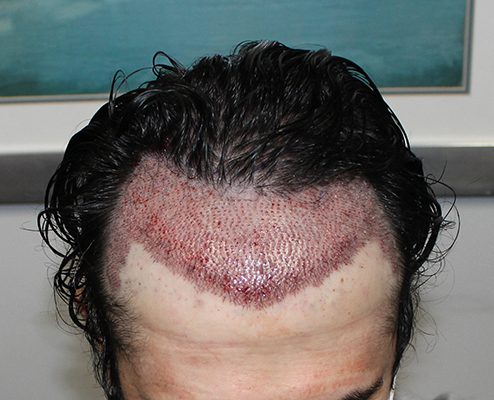What to Expect After a Hair Transplant

Hair Transplant “Post-Op”
“What will I look like after surgery?” “Will I experience discomfort?” “Do I have to take any medications?” “What special precautions do I need to take?”
These are some of the most common questions doctors are asked about the hair transplant “post-operative” or “post-op.” period. And this is very understandable; patients need to know what to expect after surgery.
Thankfully, the hair transplant post-op. and recovery period is very easy and straightforward.
Immediate Post-Op
Immediately after surgery, the area where the doctor worked is going to look slightly red, shiny, and swollen. If you look closely, you will also see thousands of new little hairs standing up where the follicular unit grafts were implanted. You will also have a small bandage around your forehead and the doctor will likely allow you to carefully wear a hat home. The doctor will provide pain medications and some antibiotic medications (or a prescription for these medications) and detailed written post-operative instructions. You will then go home to rest, relax, and recovery.
Day 1 – 4
Although estimates differ slightly, it takes approximately 4 days for the newly implanted follicles to “anchor” or take hold and become permanent. This means they are slightly vulnerable for the first few days and can be dislodged if bumped, rubbed, or touched harshly. You will sleep, bathe, and dress slightly differently for the first 3 days to avoid dislodging a graft.
It is recommended that you sleep “propped up” at a roughly 45 degree angle with something supporting your neck (either a rolled up towel or a travel neck pillow) for the first 3 nights. This is not only for support and to keep your head from moving or bumping anything in the night, but sleeping at that angle also helps discourage post-operative swelling.
Most clinics also want patients to wash the new transplants soon after surgery; most commonly, the next day. To do this safely, it is usually recommended that patients avoid direct water pressure from the shower head or excessive rubbing with shampoo application, and instead wash by gently pouring water and shampoo over the area with a cup. It is then best to simply let the transplanted region “air dry.” Even with good washing, the transplanted region may have a somewhat “scabbed” and red appearance during this time – which can be easily concealed with a hat. Button-down shirts are also recommended during this period; this is to avoid pulling anything over your head and rubbing the grafts.
Pain is minimal during this period. The only “pain” patients report is a little bit in the donor area during the first night. The clinic will provide you with medications to take during this period, and this should fully treat the discomfort. Most patients only use these medications for the first night.
Day 4 – 10
By day 4, the grafts begin anchoring and you can go back to sleeping, bathing, and dressing normally. While the grafts do not technical anchor completely until day 10, they are secure enough by the 4th day to resume basic normal activity. During this period, patients should wash more vigorously and the transplant should begin to look like a clean “buzz cut” – with the scalp clear of scabs and debris and the new transplanted hair clearly visible. There will still likely be some lingering “pinkness” of the scalp, but this will continue to gradually fade. Patients may experience some degree of swelling in the forehead, eyes, and cheeks during this period. This usually begins around day 2-3 and resides completely by day 7. The swelling is somewhat unpredictable and subjective, but sleeping “propped up” and avoiding long periods of looking downward (IE cellphone use) will help this reside quickly. For most patients, the swelling is minimal and restricted to the forehead region. During this period, you are pretty much back to “normal life” aside from staples or stitches in the donor area if an FUT procedure was performed. These will be removed around day 10.
At the 10 day mark, the grafts are fully anchored, the staples are removed (meaning you can trim the rest of your hair if desired), the transplant truly looks like a clean buzz-cut, and most patients now go back to school, work, et cetera without much unwanted attention. Most clinics will also now allow patients to resume normal exercise activity. The post-op period is truly “complete” at this point, and now patients can prepare themselves for the “fun part:” the growth phase.













